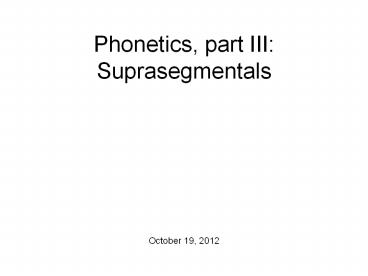Phonetics, part III: Suprasegmentals - PowerPoint PPT Presentation
1 / 15
Title:
Phonetics, part III: Suprasegmentals
Description:
Another Basic Distinction Consonants and vowels together make ... = the syllabic peak However, in English, nasals (/m ... Course Project Notes and Tips ... – PowerPoint PPT presentation
Number of Views:201
Avg rating:3.0/5.0
Title: Phonetics, part III: Suprasegmentals
1
Phonetics, part III Suprasegmentals
October 19, 2012
2
The Docket
- Morphology homeworks to hand back!
- I have mid-term review sheets, as well.
- 3. Suprasegmentals!
- Plus more phonetics practice.
- 4. Homework 2 is still due on Monday (October
22nd).
3
Another Basic Distinction
- Consonants and vowels together make up the class
of segments in phonetics. - Each segment is a configuration of
articulations - ordered in time in an utterance.
- Languages also have phonetic features which can
span across multiple segments. - suprasegmental features
- supra above the segment.
- One basic example
- Languages organize strings of segments into
syllables.
4
Syllabicity
- Syllables are hard to define phonetically
- But native speakers have an intuitive sense of
what does and does not constitute a syllable. - Normally, syllables will have
- consonants (optionally) at beginning and end
- a vowel in the middle.
- the syllabic peak
- However, in English, nasals (/m/, /n/) and
liquids (/l/, /r/) can form the peak of a
syllable. - syllabic consonants.
5
Syllabic Examples
- Syllabic consonants are transcribed with a small
vertical dash underneath them. - Examples
chasm
ribbon
eagle
feature
- The book wants you to believe that there are
vowels in these syllables ?r, ?l, etc. - but dont believe it!
6
Suprasegmentals
- Other suprasegmental features include
- Stress
- Length
- Tone
- Intonation
- These suprasegmental features are always defined
in a relative manner. - Some segments are longer than others,
- Some syllables are more stressed than others,
- etc.
7
1. Stress
- Stress makes a syllable sound more prominent.
- (due to increased articulatory effort)
- Stress may be denoted by an accent over the
vowel in the stressed syllable. - Examples of stress contrasts
- contrast
- (N)
- (V)
- insult
- (N)
- (V)
8
2. Length
- Languages can distinguish segments on the basis
of length. - some segments simply last longer than others.
- Italian contrasts both long and short vowels and
consonants.
9
Danish Vowels
- Danish contrasts long and short vowels.
10
3. Tone
- In tone languages, speakers change the rate at
which their vocal folds vibrate to signal
important differences in meaning. - Note we hear the rate of vocal fold vibration as
the pitch of a speakers voice. - In tone languages, each syllable is produced with
a characteristic tone. - Register tone languages
- Pitch must hit a certain level on any given
syllable. - Contour tone languages
- Pitch changes on a single syllable may form a
complex pattern.
11
Ibibio Tones
- Ibibio is a register tone language spoken in
southern Nigeria
12
Mandarin Tone
- Mandarin (Chinese) is a classic example of a
contour tone language.
ma1 mother ma2 hemp ma3 horse ma4 to scold
13
Mandarin Sentences
ma1-ma0 ma4 ma3. Mother scolds the horse.
ma3 ma4 ma1-ma0. The horse scolds mother.
14
Intonation
- English is not a tone language like Chinese or
Ibibio - but it has something called intonation
- English intonation
- High and Low accents attach to stressed syllables
- (transcribed with H or L)
- High and Low tones appear at the ends of phrases
and utterances. - (transcribed with H or L)
- The important difference English tones are
specified by context, not by the lexicon.
15
Intonation Examples
- In English intonation, statements usually have
- A high accented syllable (H) within the
sentence. - A low tone (L) at the end of the sentence.
- H L
- Manny came with Anna.
- Meanwhile, questions usually have
- A low accented syllable (L) within the
sentence. - A high tone (H) at the end of the sentence.
- L H
- Manny came with Anna?































